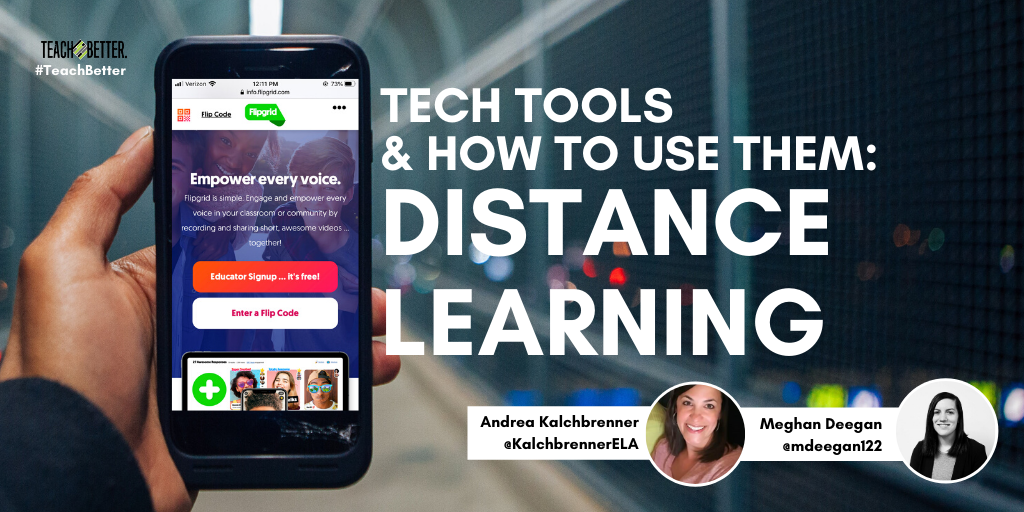TL;DR:
- Distance learning has shifted our focus toward more technology.
- A curated list of tech tools for recording videos, communicating with stakeholders, and formative assessment.
Transitioning from a classroom to distance learning can be quite the change, especially when it feels like it happens overnight. Fortunately, there are many tech tools available to help you make this new transition as smooth as possible (and fun) for you and your students. It is important to note that it is okay to start small. It is too overwhelming for you and your students to start using all of these new tools all at once. Instead, pick one at a time and go from there.
Fortunately, there are many tech tools available to help you make this new transition as smooth as possible (and fun) for you and your students. Click To TweetBelow, there are several tech tools for distance learning. Each is categorized by use.
Tech Tools for Recording Videos
If you cannot meet in person with your students, the next logical step is to record your lessons.
- Screencastify is a very simple, free application that allows you to record what is on your screen as you do a voice over. You could use this to go over directions for your E-learning assignments or to explain a new concept. You can save the videos to your Google Drive and easily upload it to Google Classroom. The only drawback is that there is a 5 minute limit on video length.
- If you need to make a longer video, Zoom is another option. Zoom offers a free version with a variety of features. The Zoom app can be downloaded to desktop computers, iPhones, and Androids. You could use this to explain directions, a singular concept, or an entire lesson. Once you have the app, you can record yourself or your screen for up to 40 minutes. This video can be uploaded to Google Drive for an easy option to share. Zoom hs been hailed as an important part of working/learning from home, it is no wonder then that people have looked to Zoom Aktie kaufen (buy a zoom share), so they can invest in this piece of technology, as it may become a huge source of communication as the years go on.
- Alternatively, you could consider recording your lesson and then uploading it to one of the online video hosting platforms, such as YouTube or Panopto. Those platforms will allow students to access these videos easily, whenever they need them. More and more E-learning organizations are beginning to use video hosting to make it easier for their students to view educational content.
Tech Tools for Communication
There are so many options available to keep in touch with students during distance learning.
- You can quickly leave a whole class or individual message on Google Classroom. You can make announcements, assignments, or just say a simple hello! If your students have an email account, send out a quick email check in and let them know you are available by email for their questions or concerns.
- Setting up a grid on Flipgrid is another fast and easy way to stay in touch. It is also free to educators. On this platform you can record and send videos back and forth with students. You can set it up so that it is a private video chat between you and the student, or you can keep it public so that students can watch each other’s videos and respond accordingly. Students really like using this platform because they can take selfies and add stickers or other silly elements to their videos. There is an option for a shareable link that will allow you to share videos with parents as well.
- If you have a Remind account, you can send students and parents messages. This app allows you to schedule announcements and allows for set office hours, so parents and students know when you are available for support. Remind allows two-way communication and has in-app translation. You can also see how many of your parents have read the messages or announcements you send.
- We mentioned the Zoom app earlier as a way to record lessons, but it can also be used as a way to communicate and host a “meeting” with your students. If you are looking to check in with them or to teach a lesson, Zoom is the perfect option!
Tech Tools for Formative Assessment
There are a variety of tools to use for formative assessment that will track data and give reports for you.
- Quizizz is a free resource that allows you to create or import already-made questions into a quiz. Once you create the quiz, you can play a live game, assign it as homework, or allow solo practice. For each option, you have the choice of allowing students single or multiple attempts, whether or not to show the answers during the game, at the end of the game, or not at all. You can also change the gameplay settings to include a few fun pieces for your students, such as: power ups (bonus points), setting a timer per question, shuffling question and answer orders, showing memes, showing a leaderboard, and offering redemption questions. You can also run a report once the quiz ends to see individually how students did.
- Another tech tool similar to Quizizz is Kahoot. Kahoot allows you to create your own questions or find a pre-made Kahoot game that meets your needs. Once you have your chosen Kahoot, you can either host a live game or create a challenge that allows students to play it at their own pace within a certain time period. You can run reports as well to show you specifically how students performed.
- Khan Academy is a free online platform that hosts so much information on a variety of topics for a multitude of grade levels. Khan Academy not only offers lessons with explanations but also practice of the concepts. You can set up classes, assign students content, and track their progress. Or you can search through the content and share links with students to offer support on specific content.
- Google Forms is an extension of Google that offers the perfect way to assess your students. Once you click on Google Forms from the Google Suite, you can create a new blank quiz. Now that you have your new quiz you have so many options! You can upload files or just type your questions, and choose how you would like your students to be able to answer. Options include short answers, paragraphs, multiple choice, checkboxes, or drop down options. You can also require students to answer certain questions or leave questions optional. Before you assign a Google Form, you can specify settings, such as collecting email addresses, limiting to one response, and shuffling question order. You can also make the Form into a quiz and assign point values for each answer. If you choose to make it a quiz, the forms will be graded for you as they are submitted.
- Newsela is a website dedicated to high-interest informational text articles for elementary through high school students. You can select articles based on a certain topic or specific standards. Newsela even offers text sets too. The best feature, in our opinion, is that there is usually at least three different Lexile levels offered for each article, which allows students to read at the level best suited for them. After most articles, there is a four question quiz and writing prompt. If you have a subscription, you can assign articles through Google Classroom and keep track of student progress with every quiz they take- not just the ones you assigned for your class.
- EdPuzzle: This tool allows you to post video tutorials for your students. You can create your own video or select a video someone else has already created. A really nice feature is that you can still edit an already-created video to fit your needs by adding in questions for students to answer while they watch the video. With the basic free version, you can save up to 20 videos; sometimes even more if you refer a colleague to EdPuzzle. You can easily assign videos through Google Classroom. EdPuzzle then creates reports for you on the progress of each of your students.

There are so many tech tools available to help our students in so many ways! The ones we discussed above are just a few that we have used in our classroom. Distance learning can be difficult, especially when it happens very quickly. But we are in this together! Remember to take everything one step at a time and use what works for you and your students. Good luck!
About Andrea Kalchbrenner
Andrea is a 7th grade ELA teacher from the Chicago suburbs and Lead Ambassador for the Teach Better team. She has been teaching for over 12 years and has a Reading Masters degree. Andrea enjoys networking and sharing her ideas with other educators on Twitter and Instagram. In addition, she loves spending time with her infant son Luke, reading, and teaching dance.
About Meghan Deegan
Meghan Deegan is a 7th grade math teacher in the Chicago suburbs and the Lead Ambassador for the Teach Better Team. She has a Masters degree in Curriculum and Instruction and is a Nationally Board Certified Teacher. She loves working with and connecting with fellow educators and is active on Twitter and Instagram.
Meghan loves spending time with her two dogs, boyfriend, family, and friends!




